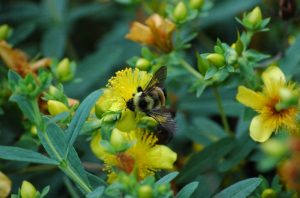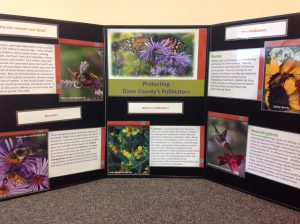Pollinator Protection in Dane County

Pollinators are animals that visit flowering plants and transfer pollen from flower to flower, thus aiding plant reproduction. North American pollinators include bees, butterflies, moths, flower flies, beetles, hummingbirds, and in some parts of the southwestern U.S. and Mexico, nectar-feeding bats. Bees purposefully collect pollen as a protein source for their offspring, making them very efficient pollinators.
Pollinators are essential to our environment as an estimated 87% of flowering plants globally rely on pollinators. They help make our ecosystems viable, and provide us with food as 150 food crops in the U.S. depend on pollinators (USDA). Odds are, you can thank a pollinator for the last meal you ate.
Unfortunately, pollinator populations have declined due to habitat loss, nutritional deficiency, pests, pathogens, insecticides, and extreme weather events. The good news is that you can help pollinators! Read below to learn more:
What can I do to protect pollinators?
- Use pollinator-friendly plants in your landscape. Ideally, this will include a variety of native flowers, grasses, trees, and shrubs.
- Reduce or eliminate pesticide use in your landscape.
- Establish a pollinator garden that has a mix of plants that bloom spring through fall. Different flower colors, shapes, and scents will attract a wide variety of pollinators.
- Provide nesting habitat. The majority of bees nest underground, so leave undisturbed bare ground with leaf litter and standing dead twigs/stems to build nesting sites.
- Volunteer to help create and maintain pollinator habitat on public land.
Learn more about pollinators with these resources:
Dane County Pollinator Protection Report | Final report of the Dane County Pollinator Protection Task Force
State of Wisconsin Pollinator Protection Plan | Contains strategies, background information, and resources for farmers, citizens, beekeepers, and others
Citizen Pollinator Monitoring Guide | Developed by Xerces Society
Wisconsin Bee Identification Guide | Developed by UW-Madison Division of Extension
Supporting Native Bees: Our Essential Pollinators | 8-page publication developed by UW-Madison Division of Extension
Saving Wisconsin’s Native Pollinators | Wisconsin Department of Natural Resources
What does a pollinator garden look like?
Dane County Extension and the Dane County Environmental Council helped establish Pollinator Teaching Gardens across Dane County to show native species that are used in a pollinator garden.
How do I establish pollinator habitat?
Whether it’s at your home, school, community center, or any other place you love, you can help establish habitat for pollinators. The first step is to assess the quality of the pollinator habitat you already have. The University of Wisconsin-Madison Gratton Lab in the Department of Entomology, Dane County UW Extension, and the Dane County Environmental Council have launched The Wisconsin Online Pollinator Habitat Assessment.
This tool is designed to give you:
- Familiarity with the features that create a healthy pollinator habitat.
- A simple, yet complete assessment of the quality of pollinator habitat for food and nesting and ways to mitigate activities that are potentially harmful to pollinators.
- A list of actions (and supporting resources) to improve the pollinator habitat on your site.
Looking for native plants? The Plant Dane Program provides Dane County residents, schools, non-profit organizations, and municipalities access to native plants at a discounted price!
Teach others about pollinators!
The Dane County Environmental Council, in cooperation with UW-Extension, has developed a set of resource materials to assist with education about the importance of and how to protect pollinators. These include: brochure, informational seed packets, a youth “fortune teller” game, and table top (36” x 72”) pollinator display boards. All can be checked out through the Dane County Natural Resource Education Center.
Pollinator Protection Brochure | Four-color brochure describing the importance of and how to protect local pollinators. Spanish version.
Pollinator Informational Seed Card | Four-color, single-fold information card that gets inserted with small amount of pollinator seeds into a bag for citizens to take action. Packet is put together as a youth or adult activity. Spanish version.
Seed Card Activity Kit | Contains a folded informational card, bowls with pollinator plant seeds, small bags, and Instructions of how to construct the seed informational packet. All this is in a tote bag that you can check out for youth or adult activity or to make as a stewardship incentive.
Youth Activity – Pollinator Fortune Teller Game | Activity is both coloring and constructing this “fortune teller” game and then playing the game while learning about pollinators. Spanish version.
Looking for pollinator curriculum? Earth Partnership at UW-Madison has developed a Pollinator Habitat Curriculum that provides specific guidance for restoring pollinator habitat on school grounds, farms, and community sites.
Pollinator Word Search | Activity developed by the USDA.
Brochure Display Holder | Four-color 11′ x 14′ free-standing display on Protecting Dane County Pollinators that contains a holder for approximately 40 brochures. Comes in 4 designs. One free holder available per organization.
Table Top Educational Display | Portable carrying case, and three-panel display board that measures 36″ x 72″. Set up with photos and text on pollinator protection on both sides of display. Topics covered include: what is a pollinator, bees and other pollinators, actions you can take to protect pollinators. Contains an interactive game on bee and wasp identification based on their characteristics. Also contains additional materials so that it can be customized to present more on habitat or other related topics. Click to see back side of display. Can be signed out free of charge for events by contacting our support staff at Extension@danecounty.gov along with many other items at the Dane County Natural Resource Education Center

Controlling Unwanted Bee or Wasp Nests
Although protection of pollinators are important, sometimes bees, or wasps, happen to make a nest in very inconvenient area where there is a threat of someone getting stung. Correctly identifying bees and wasps, and taking proper steps to prevent and control unwanted nests can help keep pollinators and people safe. Consult this article from the University of Wisconsin-Madison Extension, University of Minnesota Extension, and Iowa State University to learn more about controlling unwanted nests.




